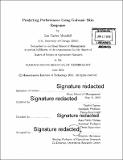| dc.contributor.advisor | Tauhid Zaman and Juan Pablo Vielma. | en_US |
| dc.contributor.author | Mundell, Lee Carter | en_US |
| dc.contributor.other | Massachusetts Institute of Technology. Operations Research Center. | en_US |
| dc.date.accessioned | 2016-10-25T19:53:16Z | |
| dc.date.available | 2016-10-25T19:53:16Z | |
| dc.date.copyright | 2016 | en_US |
| dc.date.issued | 2016 | en_US |
| dc.identifier.uri | http://hdl.handle.net/1721.1/105086 | |
| dc.description | Thesis: S.M., Massachusetts Institute of Technology, Sloan School of Management, Operations Research Center, 2016. | en_US |
| dc.description | Cataloged from PDF version of thesis. | en_US |
| dc.description | Includes bibliographical references (pages 49-52). | en_US |
| dc.description.abstract | The rapid growth of the availability of wearable biosensors has created the opportunity for using physiological signals to measure worker performance. An important question is how to use such signals to not just measure, but actually predict worker performance on a task under stressful and potentially high risk conditions. Here we show that the biological signal known as galvanic skin response (GSR) allows such a prediction. We conduct an experiment where subjects answer arithmetic questions under low and high stress conditions while having their GSR monitored. Using only the GSR measured under low stress conditions, we are able to predict which subjects will perform well under high stress conditions with a median accuracy of 75%. If we try to make similar predictions without using any biometric signals, the median accuracy is 50%. Our results suggest that performance in high stress conditions can be predicted using signals obtained from GSR sensors in low stress conditions. | en_US |
| dc.description.statementofresponsibility | by Lee Carter Mundell. | en_US |
| dc.format.extent | 52 pages | en_US |
| dc.language.iso | eng | en_US |
| dc.publisher | Massachusetts Institute of Technology | en_US |
| dc.rights | M.I.T. theses are protected by copyright. They may be viewed from this source for any purpose, but reproduction or distribution in any format is prohibited without written permission. See provided URL for inquiries about permission. | en_US |
| dc.rights.uri | http://dspace.mit.edu/handle/1721.1/7582 | en_US |
| dc.subject | Operations Research Center. | en_US |
| dc.title | Predicting performance using galvanic skin response | en_US |
| dc.title.alternative | Predicting performance using GSR | en_US |
| dc.type | Thesis | en_US |
| dc.description.degree | S.M. | en_US |
| dc.contributor.department | Massachusetts Institute of Technology. Operations Research Center | |
| dc.contributor.department | Sloan School of Management | |
| dc.identifier.oclc | 960806938 | en_US |
